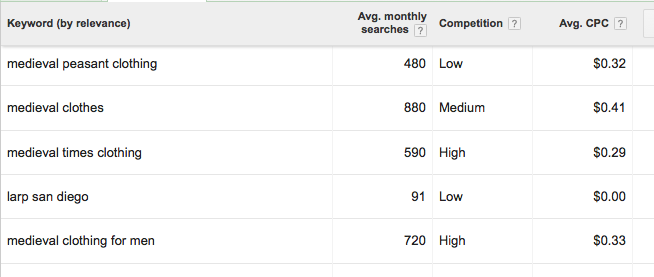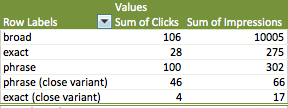In getting to know an account, a major component is your target audience. All industries have their specific clientele, and yet all industries stand to constantly reexamine what potential user they may be missing.
A client has a business that offers supplies for those interested in fantasy games involving dice and role-play. You may be a seasoned D&D player who wants to upgrade to a set of 12mm Dwarven Metal Chrome Hue Dice. You might be a secret LARPer and are finding yourself wishing you, too, had a Franciscan throwing axe.
But what this client has come to find is that there are 4 types of customers: those for whom this is a lifestyle, those who dabble in it just for fun, users who are interested in learning more, and thoughtful friends and family who are purchasing for a loved one. While any conversions are good conversions, there is different potential with the varying audiences. A student D&D group at a 4-year college could become recurring customers, tell their friends, tweet it, pin it, or comment on their new Elder Dragon Scroll playmat in their next blog post. Because of the potential within this type of user, it’s worth some thought on how to pull in these particular types of leads.
In considering how this affects your accounts, don’t assume you need a client who just promotes Magic the Gathering. It could apply to clients who are seeking leads for catering jobs, quotes for equipment repair, or information on home improvement services. The goal is to incorporate this type of thinking into your regular account assessment, so that you don’t simply rely on keyword research or broader targeting to expand your account. There is a possibility that an entire world of users is waiting for you to discover and appeal to them, simply by using this thought process.
As I mentioned, this isn’t just about keyword research. I mean, it is, but that’s not the only tool you’ve got in your belt. You’ve also got the power of search queries, ad copy, device bidding, and display targeting in your arsenal.
1. Keyword research consists of finding similar language for consistent topics in your ad groups and campaigns. There are mountains of tools you can use to prompt additional ideas and we’ve gone over them tons! But what are we missing? This is where a little out-of-the-box thinking comes into play. Doing a little research into blogs and forums, where people openly discuss their needs and experiences with my client’s product helps me create new approaches to my targeting. Things as simple as “how to fix a sea elf gill” to “activities for my 13 year-old nephew” are directions I may not have considered in basic keyword expansion. Then you can take these jewels and drop them into your keyword research tool of choice to get traffic estimates and average CPCs! 
2. SQRs: As one Sean “Excel-4-Lyfe” Quadlin recently wrote, there is opportunity for slivers of insight within your very own search query reports. Being able to sift through these results can give clear indication of what details you may be missing. The use of a pivot table in this moment is clutch. Here we can see that there is potential behind close variants to our phrase and exact keywords that we may be missing out on!

3. Ad copy: With ad copy, you have the opportunity to appeal to individuals in their moment of need. An ad that says:

is going to appeal to a D&D player who’s looking for a gift for their Dungeon Master, versus

which would certainly appeal to LARPers who specialize in Fantasy Battlewear. By taking a specific user’s motivation into consideration, you can better identify the intent through your ad text.
4. Device bids: As Google loved telling us about varying device usage (#pizza), so will I echo those thoughts. While not everything can be traced directly back to one device or another, it is certainly worth pursuing an audience through their use of a mobile gadget or computer/tablet. When appealing to the student population, for example, this client may have seen a huge spike in mobile activity. Because students love texting? Perhaps they’re waiting for the campus bus and have nothing better to do than think about what they’re going to wear to the next Society for Creative Anachronism convention. Either way, the use of mobile devices in searching can be approached in the same out-of-the-box manner.
5. Remarketing and Display: Obviously this conversation is leading to the inevitable suggestion for placement on the DN. If you have users coming to your ads based on a search for high-end costume repairs, you may make the assumption that they are an invested LARPer who may become a long-term buyer. What else will they be searching for? Spell advice? New battle strategies? Local meetup groups where they can try their hand at LARPing? These users may be great leads down the road, after they’ve seen our ads all over websites dedicated to fantasy summer camps and how to remove costume glue. This is where your choice of placements comes into play and can allow you to identify what specific sites apply to very specific audiences. LARP vs D&D vs general fantasy board games, etc.
Caveat: All the advice in the world doesn’t change the fact that you must test yo’self before your wreck yo’self (and your PPC account). Don’t just assume that your insights are going to lead this account to success. Try it. Tweak it. Track your path of action so you can return to your data in 6 months and see how you’ve done.
These 5 approaches are aimed at shining new light on your customer base. What other tips do you have? What strategies keep your insights constantly refreshed?



